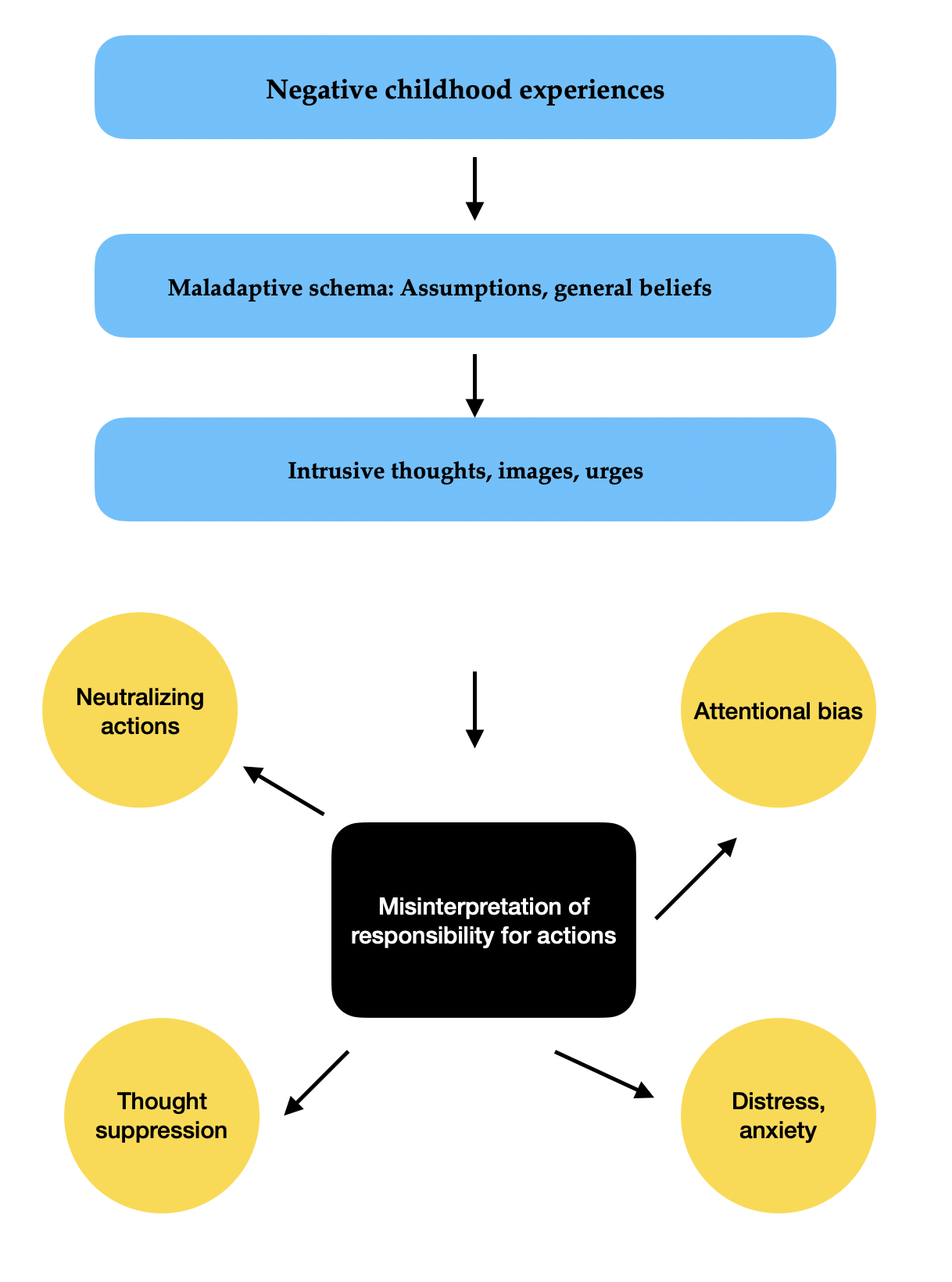Cognitive approach to OCD
 Everyone finds their mind wandering occasionally. Being distracted by our thoughts is a common experience, but people with OCD experience intrusive thoughts that are more intense, insistent, distressing, and longer-lasting than the usual interruptions faced by those without OCD. Most cognitive psychologists agree that although we may be unable to control the initial generation of such thoughts, there are individual differences in terms of the further processing that is conducted and people’s subsequent behavioural responses.
Everyone finds their mind wandering occasionally. Being distracted by our thoughts is a common experience, but people with OCD experience intrusive thoughts that are more intense, insistent, distressing, and longer-lasting than the usual interruptions faced by those without OCD. Most cognitive psychologists agree that although we may be unable to control the initial generation of such thoughts, there are individual differences in terms of the further processing that is conducted and people’s subsequent behavioural responses.
There is a wealth of research in this area, and this page focuses on two of the main cognitive theorists: Paul Salkovskis and Stanley Rachman. Both argue that beliefs about obsessions are critical in the development and persistence of the disorder.
The following video demonstrates how hard it is to control the generation of unwanted thoughts.
The role of schema: An inflated sense of responsibility
 Salkovskis (1985) proposed that intrusive thoughts activate dysfunctional beliefs about the degree of responsibility individuals should have over their own or a significant others' safety. These beliefs lead to the conclusion that something must be done about the thought in order to put matters right again. Taking actions to neutralize the thoughts leads to a reinforcement of the belief that one's actions - the compulsion - played a key role in protecting oneself or others. The reinforcement of these thoughts then makes the thoughts more likely.
Salkovskis (1985) proposed that intrusive thoughts activate dysfunctional beliefs about the degree of responsibility individuals should have over their own or a significant others' safety. These beliefs lead to the conclusion that something must be done about the thought in order to put matters right again. Taking actions to neutralize the thoughts leads to a reinforcement of the belief that one's actions - the compulsion - played a key role in protecting oneself or others. The reinforcement of these thoughts then makes the thoughts more likely.
The overestimation of one's responsibility for others may stem from strict or overprotective parenting or an experience where an individual actually did cause harm to themselves or others. This response may be the result of past experience which has led to maladaptive schema. These schema include mistrust, shame, social isolation, and vulnerability to harm.
Atalay et al (2006) administered the Young Schema Questionnaire (YSQ) and the Yale-Brown Obsessive-Compulsive Scale (Y-BOCS) to 45 patients with OCD and 45 healthy controls. The average scores of the patients with OCD on certain schemas were significantly higher than the average scores of the control group.
Salkovskis’ emphasis on perceived responsibility is supported by research such as the study by Lopatka and Rachman (1995). Participants living with OCD were put into situations that normally would provoke compulsive behaviour but they were told that they wouldn't be to blame for any negative outcomes that arose if they did not conduct their usual checking rituals. This significantly reduced discomfort and compulsive urges, as well as the perceived likelihood of a negative outcome. This important finding supports the role of an inflated sense of responsibility as a trigger for compulsive behaviour, and demonstrates how compulsions can be reduced through treatments focused on dysfunctional beliefs.
Such treatments have been shown to be effective. Ladouceur et al. (1996) found that 32 treatment sessions focused on personal responsibility reduced OCD symptoms and these gains were still present six and twelve months later. This said, there were only four people living with OCD in the study, thus responsibility may only play an important part for some people with OCD and not others
Furthermore, the treatment etiology fallacy suggests we should not assume that the success of a specific therapy proves the cause of the disorder. For example, an inflated sense of personal responsibility may be an effect of other dysfunctional beliefs associated with OCD, rather than the cause. Lopatka and Rachman’s study is somewhat helpful in resolving this issue, but their participants already had OCD, and therefore it is impossible to deduce whether inflated responsibility caused the development of the disorder in the first place.
Rachman (1997): Catastrophic misinterpretation
Rachman argues that obsessive thinking results from “catastrophic misinterpretation” of the significance of one's intrusive thoughts. Obsessions develop when the individual believes that an intrusive thought reveals something meaningful and up until now unknown about themselves, that it is a warning sign that a negative event will come true, or that it is an indication that the individual is in danger of losing control. The obsession will persist as long as the thought is interpreted as being catastrophic, and it will diminish when the misinterpretations are weakened.
While he also emphasizes the role of inflated responsibility, his theory focuses on several additional dysfunctional beliefs.

Rachman proposed that attributions of significance are critical in transforming normal intrusive thoughts into an obsession. People with OCD describe their thoughts as repugnant, alarming, and dangerous; they believe that their thoughts make them immoral, disgusting and/or insane. Often they believe hidden aspects of their character are revealed in their obsessive thoughts - that is, that deep down they are evil and at some point in the future they could be a risk to themselves or others. The anxiety that this side of them will be discovered, leading to rejection, imprisonment, or being sent to hell appears can be overwhelming.
Whereas when most people have a strange or frightening thought they are able to let it go, a person with OCD may become “stuck” on the thought and be intensely afraid that they might somehow lose control and act on it. Or worse, they believe that having the thought is just as bad as doing it. This is called thought-action fusion [TAF]. For example, a patient with OCD experienced intrusive images of throwing hot coffee in her daughter’s face or pushing her face underwater when she was giving her a bath. These images were so terrifying to the patient that she would no longer allow herself any physical contact with her daughter. She was unable to determine that the thought itself was not the same as the act or the threat of carrying out the act.
Researchers use the term thought-event fusion (TEF) to refer to the mistaken belief that thoughts can make certain events more likely (TEF), e.g. imagining the school burning down makes it more likely that the school will actually burn down.
It is interesting here to remember the pink elephant thought experiment from the video: the harder you try not to think about the pink elephant, the more impossible it becomes. Here the same can be true for people with OCD; the more they try to control their thoughts, the worse the obsessional thoughts about danger and harm become, and the more they are compelled to take responsibility by performing neutralizing behaviours.
These suggestions have been supported by experimental attempts to artificially create TAF beliefs. For example, Myers and Wells (2013) showed that intrusive thoughts, discomfort, and efforts to control thinking could all be increased in a group of people who showed no prior vulnerability to OCD-like symptoms. This was achieved by falsely telling them that an EEG was reading their thoughts, and if they thought about water or drinking this would cause them to be subjected to an aversive, but harmless noise. This is an important study as it shows that thought-action fusion may play a causal role in the development of OCD.
One problem with this study is that it only examines how obsessional thoughts about harm to self might arise through thought-action fusion and not about harm to others. This means it is difficult to say whether thought-action fusion determines intrusive thinking and distress to the same or greater degree when the harm caused by certain thoughts would befall some other person, particularly a beloved family member.
Thought suppression
 Researchers have shown that there are unexpected consequences when we actively try to avoid certain thoughts. First, you will start thinking about the thought you are trying to avoid more. Second, if the thought is about a behaviour, it is more likely that you will engage in that behaviour. In short, avoidance makes you less able to control what you think and what you do.
Researchers have shown that there are unexpected consequences when we actively try to avoid certain thoughts. First, you will start thinking about the thought you are trying to avoid more. Second, if the thought is about a behaviour, it is more likely that you will engage in that behaviour. In short, avoidance makes you less able to control what you think and what you do.
Erskine (2008) had participants suppress thoughts of chocolate and then take part in a supposedly unrelated taste preference task. Importantly participants that had previously suppressed chocolate thoughts went on to consume significantly more chocolate than the control group that had not previously suppressed.
Support from experimental studies such as Lopatka and Rachman (1995) and Myers and Wells (2013) have strong internal validity and demonstrate that altering one's beliefs can lead to changes in behaviours associated with OCD.
Biological research supports the theory that cognitive activity plays a role in OCD.
The practical application of the theories has led to successful treatments that have improved some people’s lives.
The Treatment Aetiology Fallacy – that is, the mistaken notion that the success of a treatment reveals the cause of the disorder.
Participants in supporting research studies are often people with a pre-existing diagnosis meaning it is impossible to track the acquisition of dysfunctional beliefs or schema.
Cognitive research is highly reliant on self-reported data which is open to memory distortion and cannot always be verified for accuracy.
The theories suffer from bi-directional ambiguity. It is not clear whether OCD leads to certain patterns of thinking or whether patterns of thinking lead to OCD.
It can be argued that cognitive arguments are an overly simplistic explanation of the disorder.
Cognitive psychologists believe obsessional thoughts are caused b
It is not possible to control intrusive thoughts and these are a common experience for most people but cognitive psychologists agree that it is how people interpret these thoughts that trigger obsessional thinking. Reinforcement can be part of the maintenance of compulsive behaviours, but it is not the cause of obsessional thoughts.
Salkovskis believes that which of the following dysfunctional beliefs is the most important in triggering obsessive thoughts?
Answer: Thought action fusion is an important aspect of Rachman’s cognitive theory and cognitive psychologists do consider moral perfectionism as an important trigger for OCD, but this is not specific to Salkovskis theory. Salkovksis believes that inflated sense of responsibility is the key dysfunctional belief that leads to OCD. This can lead to overestimation of negative outcomes but only in situations where the person believes they are responsible.
Which of the following terms explains the function of compulsive behaviours according to cognitive psychologists like Salkovskis?
Answer: Neutralization refers to behaviours which a person with OCD feels an uncontrollable urge to perform in order to counteract negative and potentially harmful thoughts.
Suki has obsessional thoughts about contamination. She wipes down the surfaces in her kitchen up to 60 times a day. Salkovskis suggests Suki’s obsessional worries are increased by her behaviour because…
Answer: Although all of the potential answers could be correct, the one that Salkovskis would be most likely to endorse is “the idea that she is responsible for keeping her kitchen clean”. Suki’s cleaning behaviour increases her feelings of responsibility and she then also feels overly responsible for any bad outcomes that happen to herself or others.
Salkovskis argues that inflated responsibility is caused by…
Answer: Although all of the answers could make a person more vulnerable to OCD, Salkovskis believes that inflated responsibility can result from overprotective or strict parenting.
Which of the following is a strength of the therapy delivered in the study by Ladouceur et al. (1996) focusing on personal responsibility?
Answer: This therapy actually took 32 sessions to achieve its goals so it was not a quick fix. Furthermore, the study only included four people so it cannot be said to be effective for a large and diverse sample. There is no mention of drug treatment, but the effects were still present 12 months later.
Amer has been caring for his elderly mother for the last two years. He is currently consumed with overwhelming anxiety due intrusive images of him smothering her in her sleep. He is convinced he is an evil monster and is terrified how his community will respond if and when they find out. Amer is suffering from…
Answer: Amer has thought-action fusion where he perceives the thought as morally equivalent to the action. He may also think that this thought increases the likelihood that he might actually smother his mother, (though-event fusion) but the extract does not actually mention this. In OCD it is behaviours that are described as compulsive not thoughts.
Myers and Wells demonstrated that the frequency of intrusive thoughts can be increased by creating a false sense of thought-action fusion using a sample of….
Answer: This study used a sample of healthy volunteers and showed that many features of OCD can be induced artificially in the laboratory in people with no history of OCD.
Erskine (2008) found that people who tried to suppress thoughts about chocolate…
Answer: Erskine’s study showed that thought suppression actually increased consumption of chocolate. This suggests that trying not to have a certain thought may just encourage the person to think about, or even act on that thought, more rather than less.
Bidirectional ambiguity is a criticism of the cognitive explanation of OCD meaning that participants in research studies often already have OCD so it is not possible to …
Answer: In this instance, bidirectional ambiguity refers to whether dysfunctional beliefs are a symptom (effect) of having OCD, or whether the OCD has actually been triggered by these dysfunctional beliefs. In order to know whether such beliefs are a causal factor, one would need to conduct prospective studies examining whether the acquisition of such beliefs makes people more vulnerable to OCD in the future.

 IB Docs (2) Team
IB Docs (2) Team
